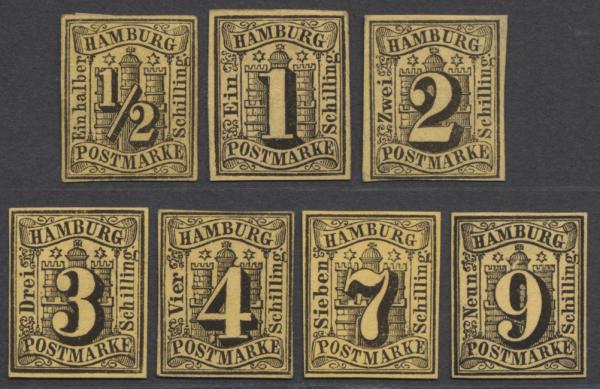 |
|||||
|
|||||
| Preview of Stamps Catalogue: VOLUME 1 |
 |
|||||
|
|||||
| Preview of Stamps Catalogue: VOLUME 1 |
Return To Catalogue - Hamburg 1864 issue - Hamburg 1866 issue - Hamburg, cancels - Hamburg, forgeries of the 1859 issue - Miscellaneous - Private issues (Boten issues), part 1 - Private issues (Boten issues), part 2 - Private issues (Boten issues), part 3 - Other private issues
Currency: 1 Hamburg Mark = 16 Schilling
Note: on my website many of the
pictures can not be seen! They are of course present in the catalogue;
contact me if you want to purchase it.
1/2 Schilling black 1 Schilling brown 2 Schilling red 2 1/2 Schilling green (1867, perforated only) 3 Schilling blue 4 Schilling green 7 Schilling orange 7 Schilling lilac (1865, only issued perforated) 9 Schilling yellow
These stamps should have a watermark 'single wavy line' (or sometimes called 'bell-curved', for an example of this watermark see the 1864 issue). Actually, the whole sheet has 12 wavy lines, surrounded by a square (which can sometimes be seen on the outer stamps of the sheet). All the forgeries don't have this watermark. The first stamps were issued on 1st January 1859.
Value of the stamps |
|||
vc = very common c = common * = not so common ** = uncommon |
*** = very uncommon R = rare RR = very rare RRR = extremely rare |
||
| Value | Unused | Used | Remarks |
| Imperforate | |||
| 1/2 s | RR | RRR | To be used for printed matter to Ritzebuttel, Bremen,
Lubeck, and Oldenburg. Later also for letters to Altona and local letters. Bisected provisionals exist to make up the 1 1/4 s rate (unofficial). |
| 1 s | RR | RR | To be used on local letters, letters to Bergedorf and
printed matter to Helgoland, The Netherlands and Great Britain. |
| 2 s | RR | RR | To be used as letter rate for other towns in Hamburg and Lubeck. |
| 3 s | RR | RR | Shades of blue. To be used on letters to Bremen and most of Oldenburg. |
| 4 s | RR | RRR | To be used on letters to Helgoland and certain towns in Oldenburg. |
| 7 s orange | RR | RR | To be used for letters to the Netherlands (after 1st
July 1859 also to Great Britain and Ireland). |
| 9 s | RRR | RRR | To be used for letters to Great Britain and Ireland
at first. Also used for other foreign letters. |
| Perforated 13 1/2 (appeared between September 1864 and April 1865) | |||
| 1/2 s | *** | *** | |
| 1 s | *** | R | |
| 2 s | R | R | Could also be used on money orders to Schleswig
Holstein and for the registration fee on letters in Hamburg. Also in use for letters to Helgoland. |
| 2 1/2 s | R | R | Issued June 1867. |
| 3 s | R | RR | Shades of blue |
| 4 s | *** | R | |
| 7 s orange | RRR | RRR | |
| 7 s lilac | *** | *** | |
| 9 s | *** | RRR | |


Genuine 9 sch stamp, front and backside (with watermark)


I've been told that these are color proofs: 4 sch blue and 9 sch
red.
The remainders of the perforated stamps were sold without gum in 1869 to Julius Goldner, a stamp dealer in Hamburg.

Block of four 9 s stamps, with numbers in the left margin.
Click here for Hamburg, cancels. Forged cancels are also described here.
Since the perforated stamps are much cheaper than the imperforate ones, often the perforation has been cut from these cheaper stamps, to make them appear 'imperforate'! Click here for more information about forgeries of this issue. In the Philatelic Journal of America March 1893, No 111, page 122, in an article translated from Hugo Krotzsch, it is said that: "As early as 1864 the 7 and 9 sch., of the first issue, appeared in counterfeits made in Hamburg."
Instruction stamps (Instruktionsmarken):

Instruction stamps
I've seen 1/2 s, 1 s, 2 s, 3 s, 4 s, 7 s and 9 s imperforate in black on yellow paper. I've been told that these are 'instruction stamps'. They were pasted on parcels of stamps, such that the clerks at the post office could easily identify which stamps were in which parcel. The only reference I could find about these stamps is in K.K.Doberer "Die Briefmarken von Altdeutschland" under the Bavaria(!) section.
Hamburg 1864 issue
Hamburg 1866 issue